Travelers from Los Angeles to San Francisco will have a lower carbon footprint this fall. Many other flights could soon follow.
If you happen to get on a United flight from Los Angeles to San Francisco this fall, you might be traveling on leftovers from the farm. The airline will be the first in the country to start flying regular passenger flights on alternative jet fuel—in the case, made from a mix of non-edible oils and agricultural waste blended with traditional fuel.
“We believe that one of our greatest opportunities to reduce the aviation industry’s environmental footprint is through sustainable alternative fuels,” says Angela Foster-Rice, United’s managing director for environmental affairs and sustainability.
United flew the first biofuel test flight in the U.S. in 2009 (using algae), and the first commercial flight in 2011. The company signed an agreement with AltAir Fuels—the company supplying the new fuel to LAX—six years ago. But it’s only now that the biofuel industry is beginning to get to the point to supply regular flights. The challenges of scaling up have involved the cost alternative fuel feedstock and raising sufficient capital investments, Foster-Rice says.
Over the next three years, United plans to buy 15 million gallons of farm waste biofuel from AltAir. This summer, they also invested $30 million in Fulcrum BioEnergy, a startup that turns household trash into jet fuel. Fulcrum’s first refinery will be finished in Nevada in 2016, down the street from Tesla’s massive new battery factory. It plans to quickly build five more.
Under current regulations, commercial flights can’t run on 100% biofuel. But the mix of conventional jet fuel and biofuel slashes carbon pollution. Fulcrum’s fuel, for example, produces lowers emissions by 80%. That’s partly because it can avoid the emissions associated with extracting and processing crude oil, and partly because it uses trash that otherwise would have had in landfills: As garbage rots, it emits methane, a potent greenhouse gas.
The cost of biofuel is also coming down, and supplies are becoming more reliable. Fulcrum has an agreement with waste management companies to keep getting a steady supply of trash. In London, British Airways is working with with another biofuel company to turn more garbage into fuel.
In the U.S., United may be first to bring biofuel mainstream, but others are planning to quickly follow, as airlines struggle to figure out how to meet goals to cut carbon emissions. Alaska Airlines will use biofuels in at least one airport by 2016; Southwest will start buying jet fuel made from wood residue.
On the LAX-SFO flights this fall, passengers won’t even realize they’ve lowered their carbon footprint. But in the future, the airline hopes to offer customers a new choice: Check here if you want to fly with biofuel.
Source: FastCompany

کتاب «چگونه به زبان همسرتان صحبت کنید»
اثر اچ. نورمن رایت، راهنمایی جامع برای زوجین است تا با مهارت های ارتباطی نوین، سوءتفاهم ها را کاهش
داده و درک متقابل را در زندگی زناشویی خود افزایش دهند.
این اثر به شما کمک می کند تا زبان منحصر به فرد
همسرتان…